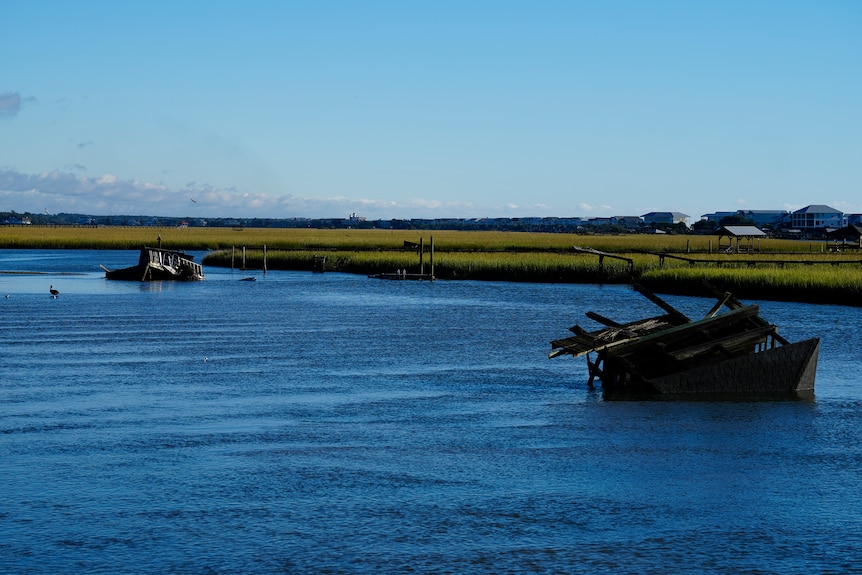Dozens of Florida residents left their flooded and splintered homes by boat and by air on Saturday as rescuers continued to search for survivors following the devastation wrought by Hurricane Ian, while authorities in South Carolina and North Carolina began taking stock of their losses.
The powerful storm terrorised millions of people for most of the week, battering western Cuba before raking across Florida, then it mustered enough strength for a final assault on South Carolina.
One of the strongest hurricanes by wind speed to ever hit the US, Hurricane Ian weakened on Saturday as it rolled into the mid-Atlantic.
However, not before it washed out bridges and piers, hurtled massive boats into buildings onshore and sheared roofs off homes, leaving hundreds of thousands without power.
At least 54 people were confirmed dead, including 47 people in Florida, mostly from drowning but others from Ian’s tragic after-effects.

An elderly couple died after their oxygen machines shut off when they lost power, authorities said.
As of Saturday, more than 1,000 people had been rescued from flooded areas along Florida’s south-western coast alone, according to Daniel Hokanson, a four-star general and head of the National Guard, who was flying to the stricken state.
Chris Schnapp was at the Port Sanibel Marina in Fort Myers on Saturday, waiting to see whether her 83-year-old mother-in-law had been evacuated from Sanibel Island.
A pontoon boat had just arrived with a load of passengers from the island — with suitcases and animals in tow — but Ms Schnapp’s mother-in-law was not among them.
“She stayed on the island. My brother-in-law and sister-in-law own two businesses over there. They evacuated,” Ms Schnapp said.
“She did not want to go, thinking it wasn’t going to be bad,” she said.
But then she got word on Friday night that her mother-in-law would be arriving at the marina.
“Now we don’t know if she’s still on the island or [has] gotten on a bus [and was taken to a shelter],” Ms Schnapp said

Survivors recall ‘insane’ scenes
South Carolina’s Pawleys Island, a beach community about 117 kilometres up the coast from Charleston, was among the places in that state hardest hit by Ian, and power remained knocked out to at least half of the island on Saturday.
Eddie Wilder, who has been coming to Pawleys Island for more than six decades, said Friday’s storm was “insane to watch”.
He said waves as high as 7.6 metres washed away the pier — an iconic landmark — just two doors down from his home.
“We watched it hit the pier and saw the pier disappear,” said Mr Wilder, whose house sits about 9 m above the ocean and stayed dry inside.
“We watched it crumble and and watched it float by with an American flag still floating.”
Pawleys pier was one of at least four along South Carolina’s coast to be destroyed during Ian’s winds and rain. Portions of the pier, including barnacle-covered pylons, littered the beach.
The intra-coastal waterway was littered with the remnants of several boat houses torn apart and knocked off their moorings in the storm.
Traffic was shut off to Pawleys Island’s southernmost point, where crews were working to clear roadways of sand and other debris that officials said has been piled at least a foot high.
The sand will later be redistributed to build back the dunes along the beach front, as happened after similar damage in 2019.

Many of the elevated beach homes still had feet of sand underneath, with dunes completely washed over and nearly flattened.
On Saturday, John Joseph — whose father built the family’s beige beach house in 1962 — said that he was elated to return from Georgetown, which took a direct hit, to find his Pawleys Island home entirely intact.
“Thank God these walls are still here, and we feel very blessed that this is the worst thing,” he said of the sand swept under his home.
“What happened in Florida — gosh, God bless us. If we’d had a Category 4, I wouldn’t be here.”
In North Carolina, the storm appeared to have mainly downed trees and power lines, leaving more than 280,000 people across the state without power late on Saturday morning, according to state officials.
At least one fatality connected to the storm was reported in Johnston County, outside of Raleigh.
A woman found her husband dead early on Saturday after he went to check on a generator running in their garage overnight, sheriff’s office Captain Jeff Caldwell said.
The storm’s winds were much weaker on Friday than during Ian’s landfall on Florida’s Gulf Coast earlier in the week.
Source: ABC News

